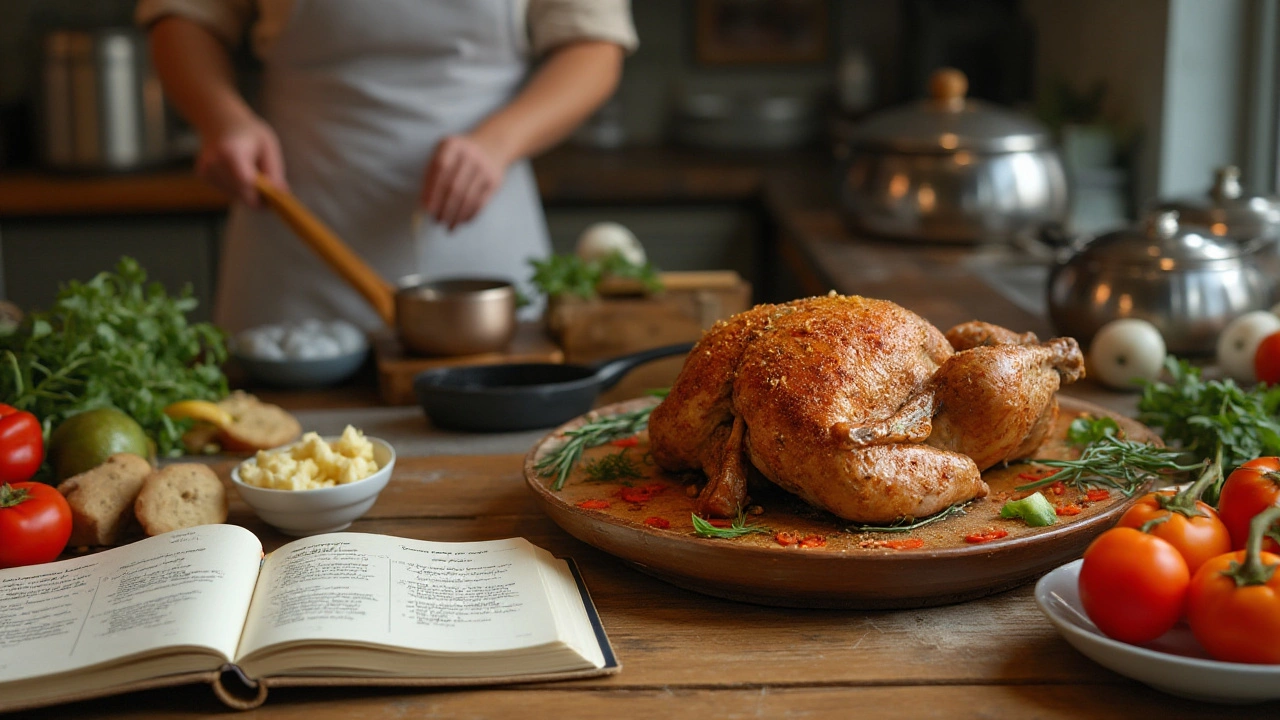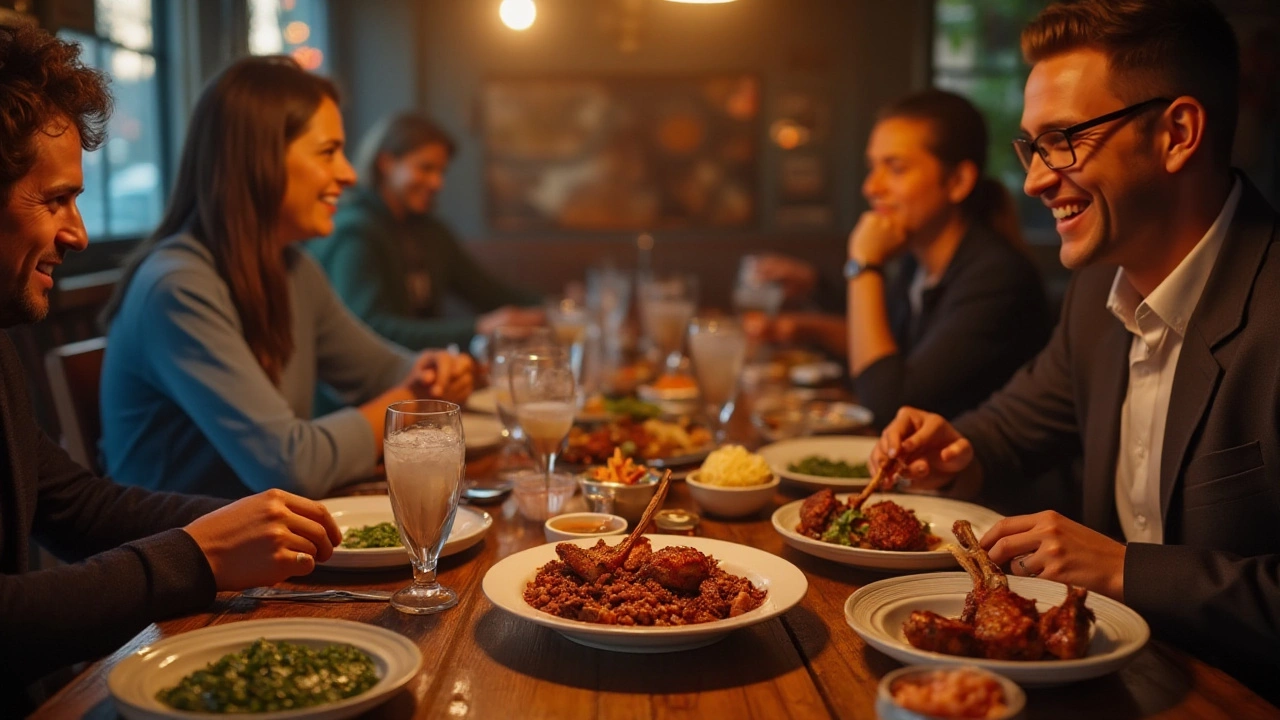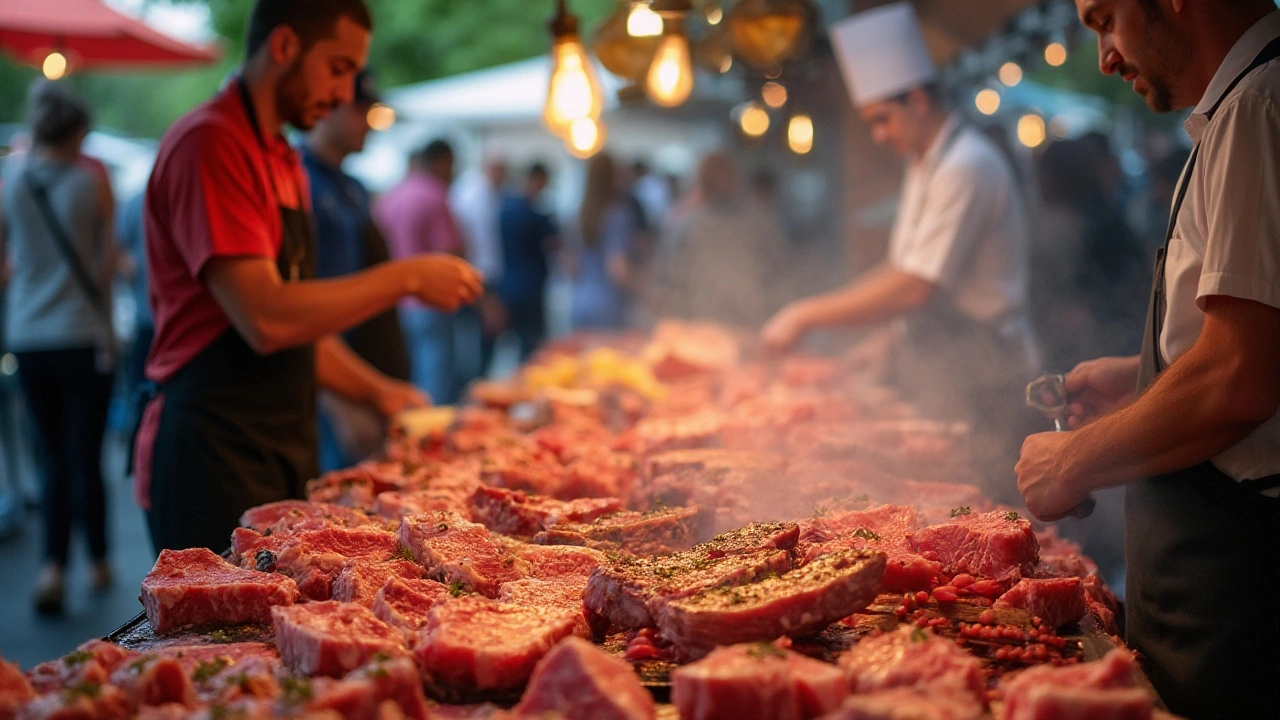Have you ever wondered which country has the most fervent passion for meat? Whether it's barbecue brisket sizzling on a Texas grill or a Sunday roast in a cozy British kitchen, meat consumption varies significantly around the world.
In this article, we will embark on a journey through various nations to uncover the leader in meat consumption, exploring what influences these preferences and how it weaves into their lifestyle and culture.
We'll not only focus on who tops the charts but will also explore delectable chicken recipes inspired by these culinary giants. Dive in as we unravel this savory topic, providing you with intriguing facts and tasty tips along the way.
- Introduction to Global Meat Consumption
- Top Meat-Eating Nations
- Cultural Influences on Diet
- Popular Chicken Dishes Around the World
- Sustainability and Ethical Considerations
- Tips for Delicious Chicken Recipes
Introduction to Global Meat Consumption
In today's world, one of the most significant aspects of any culture is its culinary traditions, and at the heart of many of these traditions is meat consumption. This isn't just about nourishing the body; it's often a social, cultural, and sometimes even a spiritual experience. Historically, our ancestors relied on hunting and gathering, evolving over millennia to develop distinct meat-based diets that were influenced by geography, climate, and the availability of resources.
The global landscape of meat consumption reveals fascinating patterns that can offer insight into a nation’s economic status, cultural preferences, and even its environmental impact. Countries like the United States and Australia have long held a reputation for their high levels of meat consumption, savored in dishes from burgers to grilled steaks. The USDA reports that the average American consumed over 220 pounds of meat in 2022—one of the highest per capita rates globally.
On the other hand, certain European nations, including Portugal and Spain, similarly enjoy high ranks in meat consumption, often reflected in their beloved regional cuisines such as cured meats and traditional roasts. According to a study by the European Union, these countries have incorporated sustainably farmed livestock practices to cope with environmental challenges.
Yet, such high consumption is not solely rooted in modern habits. It’s intriguing to note that traditional festivities and rituals in many countries feature specific meats symbolizing prosperity and communal bonds. For instance, the Argentine asado isn't merely a meal; it's a social gathering where family and friends bond over open-fire grilled meats.
"In societies around the world, sharing meat is almost synonymous with sharing happiness. The cultural rituals surrounding meat consumption often convey messages of abundance and hospitality," explains Dr. Helena Forsyth, a food anthropologist at King’s College.
However, as the love for meat spans continents, it's important to recognize the growing conversation surrounding sustainability and ethical considerations. More people are asking how to balance beloved meat traditions with environmental preservation. The fluctuating dynamics of meat consumption are not just about flavor and tradition, but about creating a sustainable future while honoring the past.
Top Meat-Eating Nations
When it comes to flexing culinary muscles over a sizzling grill or a hearty stew pot, some countries truly lead the charge in the realm of meat consumption. So, who takes the top spot? It's a tight race with surprising contenders. The United States, known for its love affair with hamburgers and steaks, consistently ranks high on the list. Australians, with their vibrant barbecue culture, also claim a significant stake, as cities like Sydney and Melbourne host some of the world's most renowned meat-centric restaurants. Meanwhile, in Argentina, beef is king, with the nation consuming over 100 pounds per person annually, its rich grassland providing the perfect environment for cattle farming.
Digging deeper, we reveal a few other surprising players. Brazil, with its famous churrasco and rodízio-style dining, ranks amongst the elite, driven by a robust livestock industry. South Korea, showcasing bulgogi and galbi, has seen a steady increase in meat consumption over the years as traditional diets mingle with Western influences. It's intriguing to consider how these palates converge and diverge in their quest to enjoy succulent, satisfying proteins.
According to the OECD, a leading organization that tracks global consumption habits, Luxembourg astonishingly takes the cake, consuming about 135 kilograms per person annually. This small nation's appetite is driven, in part, by an influx of cross-border commuters and a diverse international community bringing eclectic tastes to the table. Meanwhile, the love for poultry, especially chicken, is surging globally, posing a tasty trip through flavor and tradition. This rise leads us into some fascinating culinary cross-cultural experiences, where chicken recipes adapt and evolve to please both local and global palates.
"The more we investigate the nuances of meat consumption around the world, the more we appreciate the diversity and similarity of our shared culinary cultures," says Daniel Boucher, a respected food anthropologist.
Exploring the intricacies of these meat-loving nations, we find that economic prosperity plays a crucial role. Higher incomes generally lead to increased meat consumption, aligning with the notion that people tend to indulge more as their purchasing power rises. It's also worth noting that cultural traditions deeply ingrained in social and family gatherings often revolve around sharing a bounteous meal that largely features meat, highlighting its integral role in rituals and festivities.
Yet, it's not just about sinking your teeth into a tender cut of meat. The narrative has evolved to involve considerations of sustainability and ethics, as consumers become more conscientious about their food's impact on the planet. From farm to table, how we continue to enjoy our meat, while balancing the love for it with responsible consumption practices, is reshaping dining landscapes from Texas to Tokyo. As we explore these trends, we unearth a world where taste, culture, and responsibility meld to create a richer, more flavorful narrative.

Cultural Influences on Diet
Cultural roots shape our meals, defining not only what is on our plates but how we connect with the world around us. This intricate tapestry of traditions influences the global patterns of meat consumption, prompting questions about our shared humanity. In Argentina, for example, the national identity is closely tied to beef, especially with the beloved asado. Families gather regularly to indulge in this communal ritual, reinforcing relationships and cultural ties. Such traditions go beyond mere sustenance; they are about camaraderie and familial continuity. Japanese cuisine, on the other hand, showcases how culture influences diet through subtlety and balance. Though primarily celebrated for fish and rice, Japan has embraced chicken, introducing dishes like yakitori. The Japanese prefer local, organic meats, embracing a philosophy of respect toward what they eat as part of their deep-rooted beliefs.
The culinary landscape in India presents another fascinating example of how cultural dynamics can shape a country’s meat consumption. Despite a large vegetarian population due to religious and cultural ideals, there exists a rich tapestry of meat dishes like chicken tandoori found predominantly in non-vegetarian communities. This fusion reflects India's pluralistic society, where each cultural thread contributes to the country’s diverse food choices. Recognizing these cultural drivers helps us understand not just the practical factors but the dynamic human stories intertwined in each bite. In a thought-provoking insight, Anthony Bourdain once remarked that 'Food is everything we are. It's an extension of nationalist feeling, ethnic feeling, your personal history, your province, your region, your tribe, your grandma.'
Let's not forget the United States, where beef dominates to the point of being iconic. This stems from a confluence of economic factors and the cultural cowboy archetype engrained in the American spirit. Yet, flexibility marks the American palette, with chicken quickly rising in popularity as a leaner alternative, reflecting shifts toward healthier lifestyles. Celebrated dishes like buffalo wings and fried chicken have become staples, transcending regional borders. Interestingly, the USDA data reveals a growing trend where, since 2019, Americans consumed more chicken per capita than beef or pork. This pattern underlines a changing cultural diet, flanked by conversations around health, affordability, and diversity in recipes, stepping beyond traditional boundaries.
Popular Chicken Dishes Around the World
Exploring the diverse tapestry of culinary art around the globe, one finds that chicken holds a throne as the versatile cornerstone of numerous local traditions. From the sizzling kebabs in the bustling streets of Istanbul to the heartwarming coq au vin of rural France, chicken recipes demonstrate how universal love for this poultry transcends geographical borders. In Asia, for instance, chicken takes center stage in the tantalizing dish of "Hainanese Chicken Rice", a simple yet profound meal that involves poaching the chicken delicately to maintain its tenderness, accompanied by savory rice cooked in chicken broth. In Japan, popular izakayas serve up minced chicken yakitori skewers, often drizzled in a sweet soy glaze. These dishes do not merely satiate the palate but also provide a cultural narrative that roots back to family gatherings and heritage.
Meanwhile, in Latin America, pollo a la brasa, or rotisserie chicken, stands as a staple comfort food, particularly in Peru. The chicken is marinated with robust spices, charred to a delightful crisp over an open flame, and often served with a Peruvian green sauce that packs a punch of heat and zest. In stark contrast, India's famous butter chicken tells the story of a rich, creamy curry loaded with spices that beautifully complement the tender chicken cubes swimming within. “The first bite of a well-cooked butter chicken is like the first note in a harmoniously played symphony,” as noted by noted food critic Madhur Jaffrey.
In Europe, chicken finds its charm in the Spanish dish known as "pollo al ajillo," punched up with a garlic sauce that elevates the simple act of frying chicken into a gourmet delight. For the Brits, a Sunday roast isn’t quite complete without roast chicken, perfectly seasoned, flanked by stuffing, roasted potatoes, and Yorkshire pudding. Not too far away, the French have perfected the art of making "coq au vin," where chicken is slowly simmered in red wine, creating layers of flavor that are as sophisticated as they are comforting. These dishes showcase how chicken can be both the star of a weekday meal and the highlight of a festive banquet.
Given this array of internationally loved chicken dishes, it's no wonder that chicken remains a firm favorite among global meat eaters. Impressively, the modest chicken, whether as the fiery Nashville hot chicken from the United States or the North African tagine infused with earthy spices, endures as a culinary chameleon adapting to the spice palettes and cooking styles of the world. It's astonishing to note in a study conducted by the UN Food and Agriculture Organisation that chicken consumption witnessed a steady rise, surpassing 133 million tons worldwide annually. This signifies not just a preference but an evolving trend towards the consumption of chicken among various cultures, riding on chicken's adaptability and flavor absorbing qualities.
As we delve into these remarkable recipes across borders, keep in mind that recreating these iconic meals at home is not just an exploration of flavors but an homage to the tales that these chicken dishes hold within each bite. From a simple marinade to intricate slow-cooking methods, there is joy and satisfaction in understanding the traditional techniques that render these meals timeless.

Sustainability and Ethical Considerations
As we delve into the topic of meat consumption across the globe, it's crucial to address the sustainability concerns that accompany this widespread dietary habit. Livestock farming significantly contributes to greenhouse gas emissions, with the meat industry accounting for around 14.5% of global emissions, according to the Food and Agriculture Organization of the United Nations. This underscores the pressing need to evaluate the impact meat lovers have on the environment. Actions like deforestation, which makes way for grazing lands, exacerbate the carbon footprint. From the bustling urban centers of the United States to the expansive outback of Australia, the environmental costs of satisfying our hunger for meat are profound and far-reaching.
The ethics surrounding meat consumption also invite discussion about animal welfare. The conditions in which many animals are raised, particularly in intensive farming systems, often spark debates about morality and cruelty. To counter these practices, there's a growing movement advocating for more humane and ethical approaches to raising livestock. For instance, free-range farming has gained traction as a more ethical alternative, ensuring animals have space to roam and behave naturally. This movement isn't only about ethics; consumers play a pivotal role by demanding transparency and sustainability, thereby influencing company practices and encouraging a shift towards environmentally friendly policies.
As consumers become more aware, there's an increasing demand for sustainable and ethically produced meats. Terms like 'organic', 'grass-fed', and 'antibiotic-free' are becoming buzzwords in the industry, appealing to those who look to align their culinary preferences with their ethical values. This shift isn't just limited to individual consumption patterns. Governments and environmental bodies globally are introducing policies to curb the impact of meat production. Encouragingly, there has been substantial debate among policy-makers on implementing measures like carbon taxes for emissions-heavy industries, including meat production.
Moreover, with innovative solutions like lab-grown meat and plant-based alternatives emerging, we are witnessing an exciting evolution in the industry's approach to sustainability. These alternatives pose promising potential in easing the environmental strain caused by traditional meat production methods. They also cater to a growing segment of the population that desires the taste and experience of meat without the associated ethical concerns.
It's a dynamic world we live in, where Dr. Patrick Brown, founder of Impossible Foods, has been quoted saying, "We are on a mission to transform the global food system, one burger at a time," which reflects the visionary steps taken to reduce our ecological footprint.
As we consider the implications of meat consumption, it's essential for each of us to envision a balanced future where satisfying our culinary desires doesn't cost the planet or compromise ethical standards. This growing awareness is gently nudging consumers towards re-evaluating their choices, prompting them to reflect on their individual roles in fostering a more sustainable and ethically conscious global community. It's about striking that fine balance between enjoying our meals and ensuring that our planet remains abundant and thriving for generations to come.
Tips for Delicious Chicken Recipes
Crafting a mouth-watering chicken dish can seem like an art, but it’s one that you can master with just a bit of guidance. The first step in creating memorable chicken recipes is starting with quality, fresh ingredients. The meat itself should be fresh, preferably free-range or organic for the best taste and texture. These chickens are not just ethically sourced, but the flavors are richer and more satisfying. When marinating your meat, ensure it is soaked in the marinade for at least a few hours—overnight if possible. This allows the flavors to deeply penetrate the flesh, creating a more vibrant taste with every bite. An insider’s tip is to score the chicken lightly with a knife before marinating, allowing the spices and herbs to seep in even further.
A critical step many overlook is the seasoning. Contrary to popular misconceptions, seasoning shouldn’t be heavy; instead, it should be balanced and nuanced with layers built throughout the preparation process. Start with a base of salt and pepper, adding more complex herbs like rosemary or thyme as you cook. This step ensures that your chicken isn’t just surface season—each bite should be as flavorful as the last. A well-seasoned chicken recipe also often calls for a balance of acidity, sourced from a splash of lemon or a dash of vinegar. This not only brightens the overall dish but aids in the tenderizing process.
Cooking Techniques to Elevate Your Dish
The method of cooking can define your dish. Grilling, for example, gives a smoky char that can't be replicated and is ideal for a summer barbecue. When grilling, ensure the grill is adequately preheated. A common mistake is placing the chicken on a cold grill, causing uneven cooking and potential sticking. For an oven-roasted alternative, consider using a convection setting to circulate hot air, resulting in a crispy skin while retaining succulent, juicy meat inside.
"Cooking is an art and patience a virtue... Careful attention to each step in your recipe can make the difference between a good dish and a great one," says renowned chef Julia Child.Remember, when baking or roasting chicken, resting the meat after cooking is just as important as the cooking itself. Letting it sit for a few minutes retains those precious juices, which can make all the difference in retaining moisture.
Experiment with Exciting Flavors
One of the joys of creating chicken recipes is the playground of flavors you can explore. From Asian-inspired dishes to Mediterranean delights, the world is your oyster—or rather, your chicken! Dive into exotic spices like turmeric and cumin for a warm, earthy aroma or explore umami-rich ingredients like soy sauce and brown sugar for something sweet and savory. A pro tip is to toast whole spices before using them to release their essential oils, significantly enhancing their fragrance. Popular Chicken Dishes from different global regions provide adaptable templates to experiment with your flavor adventures. Discovering your personal preferences is part of the culinary journey, and you can start with easy, incremental changes like adding a pinch of paprika or a dash of hot sauce to a familiar recipe. This experimentation not only diversifies your home-cooked meals but also enriches your palette, making meal times exciting in the comfort of your own kitchen.
| Cooking Method | Key Benefit |
|---|---|
| Grilling | Smokey, Charred Flavor |
| Roasting | Retains Juiciness |
| Stir-frying | Speedy Cooking |
So roll up your sleeves, gather those fresh ingredients, and let the world of chicken recipes inspire your next culinary masterpiece. Whether you’re preparing for a family dinner or an intimate date night, rest assured these tips will gear you towards creating a chicken dish that's not just nourishing, but irresistibly delectable, etching a memory for everyone at the table. Bon appétit!

